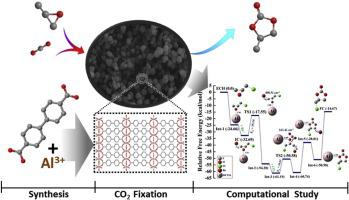Catalysis Today ( IF 5.2 ) Pub Date : 2019-12-31 , DOI: 10.1016/j.cattod.2019.12.038 Jintu Francis Kurisingal , Yixin Li , Yryskul Sagynbayeva , Ramesh Kumar Chitumalla , Srimai Vuppala , Yadagiri Rachuri , Yunjang Gu , Joonkyung Jang , Dae-Won Park

|
Two aluminum-based DUT (Dresden University of Technology) metal organic frameworks were synthesized, and their structural and chemical properties were exploited for the cycloaddition reaction of CO2 and epoxide under solvent-free condition. Both the catalysts have the same supramolecular architecture but different ligands. DUT-5 (Al(OH)(bpdc), bpdc = 4,4′-biphenyldicarboxylate) has a higher number of acidic and basic sites and larger BET surface area and specific pore volume compared with DUT-4 (Al(OH)(ndc), ndc = 2,6-naphthalenedicarboxylate). The highly porous DUT-5 exhibited better catalytic conversion of epichlorohydrin (ECH) than DUT-4, with >99 % selectivity in the presence of tetrabutylammonium bromide (TBAB). Short linkered MIL-53 (MIL = Materials Institute Lavoisier) (Al(OH)(bdc), bdc = 1,4-benzenedicarboxylate) exhibited lower ECH conversion compared with DUT-4 and DUT-5, even though all the catalysts possessed the same crystal structure. DUT catalyst could be recycled at least five times without any noticeable loss in the ECH conversion. In addition, the mechanism for the DUT-5/TBAB mediated cycloaddition of CO2 to ECH, affording the five‐membered ECH carbonate, has been investigated in detail using the density functional theory. The energy barrier for the ECH ring opening in the presence of DUT-5/TBAB (15.14 kcal/mol) is significantly lower than those of un-catalyzed (61.96 kcal/mol) and TBAB-catalyzed (39.60 kcal/mol) reactions, clearly showing the vital role of the Al3+/Br− bifunctional catalyst system.
中文翻译:

多孔铝基DUT金属-有机框架,用于将CO 2转化为环状碳酸酯:计算支持的研究
合成了两种铝基DUT(德累斯顿工业大学)金属有机骨架,并利用它们的结构和化学性质进行CO 2的环加成反应和无溶剂条件下的环氧化物。两种催化剂具有相同的超分子结构,但具有不同的配体。与DUT-4(Al(OH)( ndc),ndc = 2,6-萘二甲酸)。在四丁基溴化铵(TBAB)存在下,高孔隙度的DUT-5表现出比DUT-4更好的表氯醇(ECH)催化转化率,选择性> 99%。与DUT-4和DUT-5相比,短连接的MIL-53(MIL =材料研究所Lavoisier)(Al(OH)(bdc),bdc = 1,4-苯二甲酸酯)表现出较低的ECH转化率,即使所有催化剂都具有相同的晶体结构。DUT催化剂可以循环使用至少五次,而ECH转化率没有任何明显的损失。此外,DUT-5 / TBAB介导的CO环加成反应的机理使用密度泛函理论对ECH 2的五元碳酸盐进行了详细研究。在DUT-5 / TBAB(15.14 kcal / mol)存在的情况下ECH开环的能垒显着低于未催化(61.96 kcal / mol)和TBAB催化(39.60 kcal / mol)的能垒,清楚地示出了Al的至关重要的作用3+ /溴-双功能催化剂体系。











































 京公网安备 11010802027423号
京公网安备 11010802027423号